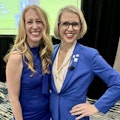The great disruption: Dental hygiene education during the pandemic
The year 2020 brought an incredible disruption to the dental hygiene profession. A global pandemic spread through infectious aerosols impacted the entire dental community. N95 masks, face shields, and patient screening forms aside, dentistry, like many other professions, has also experienced a disruption in the availability of employable dental hygienists to meet the growing needs of communities.
Prior to the pandemic, there were long-term concerns regarding employment shortages as dental hygienists classified as baby boomers (born 1946–1964) were expected to retire at an alarming rate, leading to a 22% decline in available dental professionals.1 The COVID-19 pandemic accelerated this attrition within dental hygiene employment across the United States. Dental hygiene staffing has dropped an estimated 8% during the pandemic as a concerning result of declined attitudes toward the dental hygiene profession.2 With this decline in the available workforce, it has become critical to evaluate not only how to support but also how to warmly welcome new dental hygiene graduates to the profession with socially distanced open arms and mentorship.
The problem
With the lockdown in full force, dentistry sat in a proverbial “waiting room,” unsure about how long we would be, well, waiting. As dental practices began to loosely define “emergency” patients requiring treatments, struggle through supply chain challenges to acquire appropriate personal protective equipment, and adjust protocols for patient screenings, the dental hygiene education community also began to pivot.
Growing your dental hygiene career path through medical-dental integration
Advocacy and lobbying as a dental professional: Finding your voice
For dental hygiene education, the result became a dramatic shift from an in-person learning environment to leveraging the use of online resources in a “virtual classroom.” While the country fought over toilet paper, dental hygiene faculty scurried to digitize their existing lectures to accommodate asynchronous learning. Many educational institutions already had a digital platform for students and faculty to communicate; however, the unfamiliar educational setting of a complete virtual learning experience dramatically reduced classroom engagement. The all-too-familiar messy bun, sweatpants, and iced coffee we shared in study groups pivoted into online meetings, webinars, and virtual learning platforms.
In addition, the shift to an entirely virtual learning experience created a challenge in large portions of the dental hygiene curriculum that relied on begging our family and friends to come in as patients for clinical training. This has resulted in a lack of ample hands-on experiences and subsequent anxiety for students whose foundational psychomotor skill training was dramatically impacted by the educational shift.3 Dental hygiene school, a rite of passage not only in academia but an initiation to the tireless work required of a practicing hygienist, became nearly impossible overnight.
The consequences
Dental hygiene faculty began to observe advantages in online learning, such as encouraging students to work at their own pace. Virtual classes could accommodate diverse learning styles, and it was accessible and efficient. But the disadvantages of online learning created a new series of challenges; most notably, online learning requires self-motivation, self-organization, and a suitable learning environment. Additionally, the minimal interaction between instructors and students may have a lasting impact on how confident dental hygiene students, and subsequently new graduates, feel in asking for help or seeking mentorship from colleagues and seasoned hygienists.
Dental hygiene students also observed an immediate dramatic shift in their education. Students remarked on the lack of peer-to-peer engagement and learning challenges around their digitized lectures, indicating that narrations were not helpful when the faculty member simply read what was written on the slide. In turn, there was a generalized observation across the US of student disengagement and one-way, teacher-dominated learning experiences.4
The result of these educational pivots has undeniably affected the trajectory of pandemic students’ careers. Influential factors such as educational debt, declined mentorship by faculty members, reduced national incomes, and changes in regulatory guidelines present a myriad of external influences that are believed to have a potential impact on overall career trajectory and satisfaction for postgraduate dental hygienists.5
Put simply: dentistry was well adjusted to the zest and vigor new graduates would typically sprinkle into the profession. Now, however, new graduates are conceivably less skilled and significantly more fearful of their chosen profession.
Potential solutions
While the ongoing global pandemic has encouraged modifications to clinical dentistry, academic institutions are called upon to consider modifying their previous teaching models to accommodate new learning styles. Additionally, focus must turn to addressing potential future external barriers that have emerged due to the COVID-19 health crisis. Many academic institutions are considering permanent hybrid settings for appropriate coursework as well as additional private practice simulations for optimal collaborative and active learning. To prevent teacher-dominated learning, educators have begun breaking longer lectures into smaller ones to elicit response and engagement through quizzing platforms such as Kahoot! Some even have brief one-on-one check-ins with students to evaluate their success in the hybrid-learning setting.
Most current dental hygiene students are from Generation Z (born 1997–2012), and as such, the future of dental hygiene education will need to continue to pivot to meet the unique needs of Gen Z and subsequent Generation alpha (born 2010–2024) student populations.
April Turner, EdD, MSDH, RDH, dissected the learning styles of Gen Z individuals in her dissertation, and discovered that this cohort prefers an active learning style. Gen Zers want engaging education with interaction to continually demonstrate and evaluate their knowledge. They also appreciate learner-generated content such as videos and blogs shared with colleagues. Collaboration and social interactions are of great value for this generation, which made learning challenging during the shelter-in-place orders across the country.6
While our incredible educators continue to roll up their lab coat sleeves to re-create the dental hygiene education experience, employers, colleagues, and ultimately the “other side” of hygiene school are called upon to welcome and nurture new graduates into the fast-paced, ever-evolving world of dentistry. Dentists and senior hygienists in the practice may consider offering a preceptorship-like program prior to a traditional working interview for new-hire hygienists as a means of accommodating new learning styles. Better understanding the unique needs of a new hire can promote employment longevity as the organization implements and nurtures their preferred learning style of integrative and collaborative learning.
With the toss of a -graduation cap, recent graduates are -expected to evolve from the several-hours-long multiple-appointment model of hygiene school to treating their private-practice patients in one hour, sometimes less. Seasoned clinicians well remember the struggles of the transition into the professional setting and can mentor new graduates to ensure continuing success within the profession. This harsh transition can be softened by supplemental training to include periodic calibration sessions that can encourage mentorship and the active learning style Gen Zers prefer.
New dental hygiene graduate Navreen Kang, BSDH, RDH, says her virtual learning experience was not necessarily challenging, and she noted a generalized lack of engagement. Moving into the private practice setting, she found that although the current demand for dental hygienists is high, the expectations were even higher to catch up on patient care due to extreme delays in scheduled dental visits. “I knew that I was going to see patients at my working interview, but I was only briefed about the practice and its protocols for 30 minutes. How does that set me up for success to represent the practice well?” Kang asks. This question is one that the dental community can answer together for our new graduates.
Although we can support new graduates in their success, new hygienists must also take command of their own careers and commit to clinical excellence. Dental hygiene school teaches foundational basics for success on both clinical and written boards, yet higher learning and continuing education programs offer the opportunity to sharpen hand skills, particularly with aerosol-generating procedures, explore advanced clinical data, and collaborate on clinical decision-making skills. While new graduates may not have immediate continuing education requirements for licensure, perhaps taking the initiative to seek higher learning early in the hygiene career can help expand their clinical skills or simply encourage connection and calibration with seasoned mentors in private practice by taking coursework together.
Conclusion
If this global health crisis has taught us anything, it’s that dentistry is resilient and adaptable. With the global pandemic disrupting dentistry and dental education, professionals, educators, and students alike were confronted with the challenge of how to best serve their communities in the aftermath.
The employment shortage has heavily impacted the bottom line of the business of dentistry as well as the oral health of our communities. As we return to a new normal of practicing dentistry, we must acknowledge and embrace the next generation of hygienists as the future of our profession, as they will ultimately carry the torch for generations to come.
Always leave things better than you found them … especially people. —Henry Cloud
Editor's note:This article appeared in the December 2022 print edition of RDH magazine. Dental hygienists in North America are eligible for a complimentary print subscription. Sign up here.References
- Schofield DJ, Fletcher SL. Baby boomer retirement and the future of dentistry. Aust Dent J. 2007;52(2):138-143. doi:10.1111/j.1834-7819.2007.tb00479.x
- Gurenlian JR, Morrissey R, Estrich CG, et al. Employment patterns of dental hygienists in the United States during the COVID-19 pandemic. J Dent Hyg. 2021;95(1):17-24.
- Gebril M, Brillant MS, Glogauer M, Seth S. Evaluation of the online learning experience of Dalhousie dentistry and dental hygiene students during COVID-19 pandemic outbreak. J Can Dent Assoc. 2021;87(l18):1488-2159.
- Wanner T. Enhancing student engagement and active learning through just-in-time teaching and the use of PowerPoint. Int J Teach Learn Higher Educ. 2015;27(1):154-163.
- García DT, Akinkugbe AA, Mosavel M, Smith CS, Brickhouse TH. COVID-19 and dental and dental hygiene students’ career plans. JDR Clin Trans Res. 2021;6(2):153-160. doi:10.1177/2380084420984772
- Turner AM. Comparison of Generation Z and Millennial dental hygiene students’ preferred learning styles (Publication No. 29393558) Doctoral dissertation, Grand Canyon University. ProQuest Dissertations and Theses Global; 2022.
About the Author

Kevin Ohashi Lopez, MHA, BSDH, RDH
Kevin Ohashi Lopez, MHA, BSDH, RDH, is a San Francisco-based dental hygienist. He graduated from West Coast University in 2019 and obtained a master's in health administration. Currently practicing in Napa Valley, Kevin brings diverse dental experience, with both front- and back-office expertise. He is a speaker, ambassador, mentor, Guided Biofilm Therapy trainer with the Swiss Dental Academy, and NBDHE review faculty with Sanders Board Preparatory. Connect with him on Instagram @kevstalksteeth or via email at [email protected].

Katrina M. Sanders-Stewart, MEd, BSDH, RDH, RF
A clinical dental hygienist, author and international speaker, Katrina is passionate about elevating the dental profession by creating an undeniable movement that educates, encourages, and empowers the profession to rise in its power. Known as the “Dental WINEgenist™,” she pairs her desire for excellence in the dental industry with her knowledge and passion for wine. She is the Clinical Liaison for Hygiene Excellence at AZPerio, founder of Sanders Board Preparatory and has been published in various publications including RDH Magazine and Dental Academy of Continuing Dental Education. Recently, Katrina proudly received the University of Minnesota Distinguished Alumni Award and the 2024 Sunstar Award of Distinction. @TheDentalWINEgenist [email protected].
